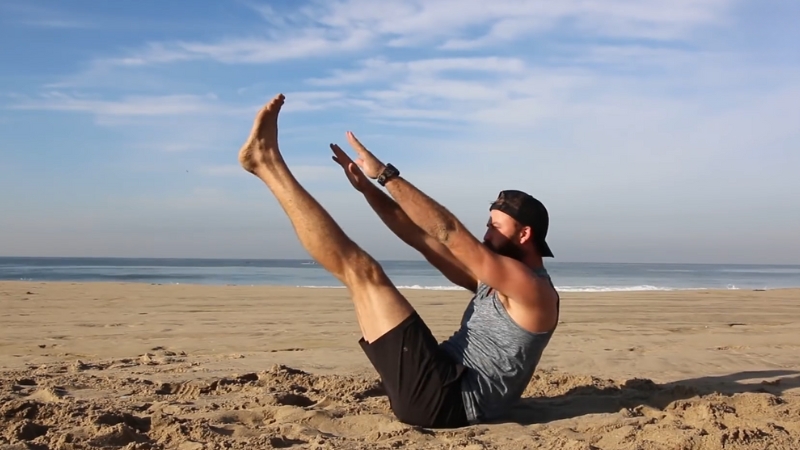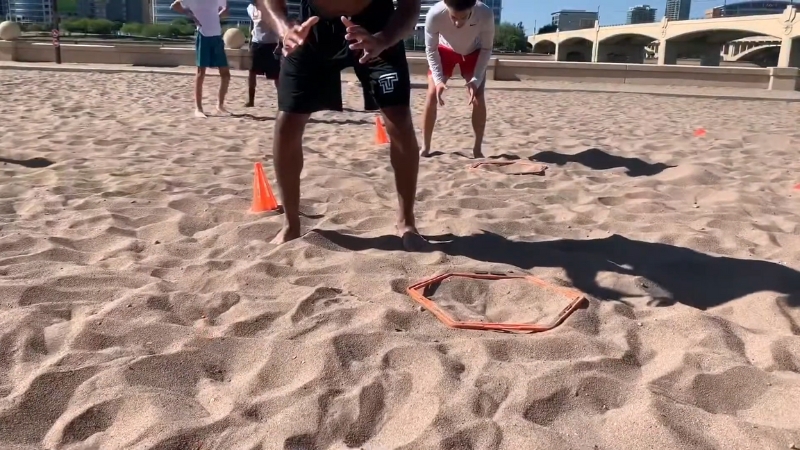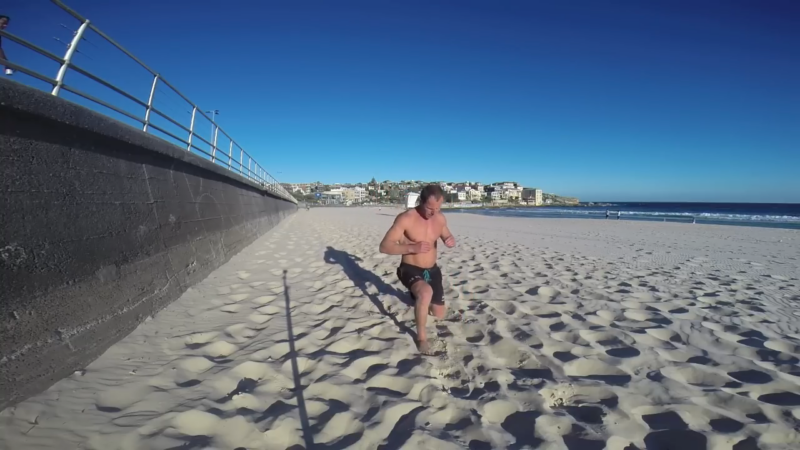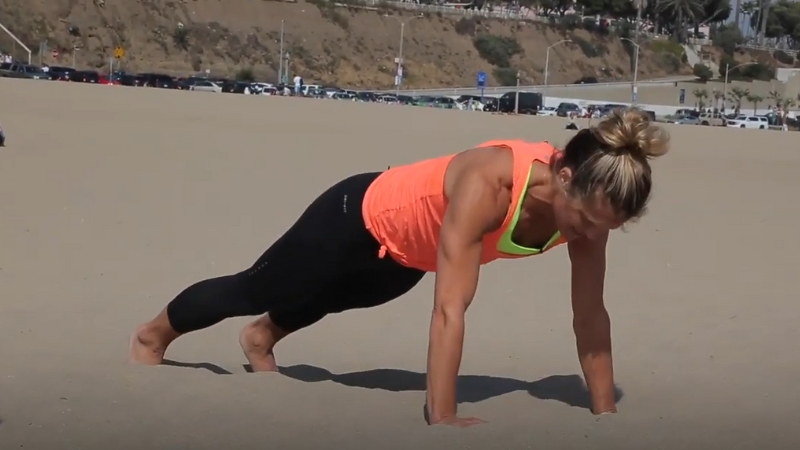Sand
training
is
an
effective
way
to
elevate
fitness
levels
by
engaging
muscles
in
ways
that
solid
ground
cannot.
The
soft,
shifting
surface
forces
the
body
to
adapt,
requiring
more
strength,
balance,
and
endurance.
Athletes
and
fitness
enthusiasts
use
sand
workouts
to
increase
muscle
activation,
reduce
joint
stress,
and
improve
overall
conditioning.
The
benefits
range
from
calorie-burning
efficiency
to
enhanced
stability,
making
sand
workouts
a
powerful
addition
to
any
routine.
1.
Strengthens
Stabilizing
Muscles

Youtube/Screenshot,
Sand’s
instability
activates
foot
and
ankle
stabilizers
Training
on
sand
engages
muscles
that
often
remain
underutilized
on
solid
ground.
The
soft
and
shifting
surface
forces
the
body
to
constantly
adjust,
requiring
smaller
stabilizing
muscles
in
the
feet,
ankles,
and
legs
to
work
harder.
How
Sand
Training
Activates
Stabilizing
Muscles
The
instability
of
sand
requires
continuous
micro-adjustments,
leading
to
increased
activation
of
foot
and
ankle
stabilizers.
Unlike
firm
surfaces,
sand
prevents
the
body
from
relying
too
heavily
on
momentum,
demanding
more
effort
with
every
movement.
These
adjustments
strengthen
the
connective
tissues
around
the
joints,
improving
resilience
against
sudden
movements
or
changes
in
direction.
The
constant
need
for
stabilization
enhances
muscle
coordination
and
control,
which
translates
to
better
movement
efficiency.
This
is
especially
important
for
athletes
who
engage
in
sports
requiring
agility,
such
as:
- Soccer
- Basketball
- Tennis
The
ability
to
quickly
shift
weight
and
maintain
stability
under
changing
conditions
is
a
key
component
of
athletic
performance.
Biomechanical
Benefits
of
Sand
Training
Enhances
foot
and
ankle
stability,
reducing
the
risk
of
rolling
or
twisting
during
dynamic
movements.
Strengthens
muscles
responsible
for
maintaining
posture
and
alignment,
improving
overall
movement
mechanics.
Encourages
a
more
natural
gait
cycle
by
reducing
reliance
on
artificial
support
provided
by
hard
surfaces.
Regular
sand
workouts
contribute
to
long-term
joint
health
by
reinforcing
the
muscles
and
tendons
that
support
the
lower
body.
This
not
only
helps
with
performance
but
also
minimizes
the
likelihood
of
overuse
injuries
that
are
common
in
repetitive-impact
sports.
Why
Athletes
Use
Sand
for
Stability
Training
Many
professional
athletes
integrate
sand-based
drills
into
their
routines
to
strengthen
foot
muscles
and
improve
balance.
The
resistance
created
by
sand
forces
the
lower
body
to
generate
more
power
with
each
step,
leading
to
greater
strength
development.
This
type
of
training
proves
beneficial
in
multiple
sports
and
physical
activities.
-
Sprinting
and
jumping
on
sand
increases
the
demand
for
lower-body
control,
which
translates
to
better
acceleration
and
deceleration. -
Bodyweight
exercises
such
as
lunges,
squats,
and
lateral
shuffles
become
more
effective
due
to
the
added
difficulty
of
maintaining
balance. -
Sports
like
beach
volleyball,
football,
and
martial
arts
benefit
greatly
from
the
enhanced
footwork
and
stabilization
achieved
through
sand
workouts.
Training
in
sand
promotes
functional
strength,
meaning
the
improvements
carry
over
to
real-world
movements.
Unlike
machine-based
exercises
that
isolate
specific
muscle
groups,
training
requires
full-body
coordination.
2.
Low-Impact
Training
for
Joint
Health

Youtube/Screenshot,
Sand
reduces
joint
strain
by
absorbing
impact
One
of
the
primary
advantages
of
sand
workouts
is
their
ability
to
absorb
impact,
significantly
reducing
stress
on
the
joints.
Unlike
concrete
or
asphalt,
which
transfers
force
back
into
the
body
with
each
step,
it
disperses
pressure
evenly.
This
makes
it
an
excellent
choice
for
individuals
recovering
from
injuries
or
those
looking
for
a
safer
alternative
to
traditional
running
surfaces.
How
Sand
Training
Protects
Joint
Health
Sand
naturally
cushions
each
step,
lowering
the
force
exerted
on
joints
compared
to
hard
surfaces.
Instead
of
concentrating
stress
on
specific
areas
like
knees
and
ankles,
it
spreads
the
load
across
a
wider
surface.
More
effort
is
placed
on
muscle
engagement
rather
than
bone
or
joint
pressure,
promoting
strength
without
excessive
wear.
Sand’s
cushioning
effect
allows
for
repetitive
movement
without
excessive
strain.
This
is
particularly
beneficial
for
runners,
as
long-term
exposure
to
hard
surfaces
can
lead
to
joint
wear
and
tear.
With
reduced
impact,
the
likelihood
of
conditions
such
as:
-
Shin
splints -
Stress
fractures -
Knee
pain -
Hip
discomfort
decreases
significantly.
Individuals
who
experience
joint
discomfort
during
regular
workouts
often
find
relief
when
switching
to
sand-based
training.
Ideal
for
Injury
Recovery
and
Prevention

Youtube/Screenshot,
Sand
increases
effort,
strengthening
muscles
around
joints
with
less
stress
Physical
therapists
often
recommend
sand
workouts
for
recovering
athletes,
as
they
provide
resistance
without
high
impact.
Sand
requires
more
effort
to
push
off,
which
strengthens
muscles
around
joints
while
keeping
stress
levels
low.
Older
individuals
often
struggle
with
cartilage
deterioration
and
joint
pain.
Sand
provides
a
way
to
stay
active
without
worsening
these
issues.
A
Long-Term
Fitness
Solution
Beyond
injury
prevention,
this
softer
surface
promotes
longevity
in
fitness.
Long-distance
runners,
sprinters,
and
athletes
can
incorporate
sand
training
to
maintain
endurance
while
minimizing
physical
toll.
3.
Burns
More
Calories
in
Less
Time

Youtube/Screenshot,
HIIT
circuits
are
more
effective
with
the
added
resistance
of
sand
Training
on
sand
requires
significantly
more
effort
compared
to
workouts
on
solid
ground.
The
unstable
surface
forces
the
body
to
work
harder
with
every
movement,
leading
to
increased
calorie
burn.
Studies
have
demonstrated
that
running
on
sand
demands
up
to
1.6
times
more
energy
than
running
on
stable
terrain,
making
it
one
of
the
most
effective
ways
to
accelerate
fat
loss.
Unlike
treadmill
running
or
pavement
sprints,
sand
training
eliminates
the
ability
to
build
momentum.
Each
step
requires
a
fresh
push-off,
engaging
more
muscle
fibers
to
drive
forward.
This
additional
effort
results
in:
-
Higher
heart
rate:
Sand
resistance
forces
the
cardiovascular
system
to
work
harder,
improving
endurance
while
increasing
metabolism. -
Increased
muscle
activation:
More
muscle
groups,
including
smaller
stabilizers,
must
work
to
maintain
balance
and
forward
motion. -
Greater
oxygen
consumption:
The
body
requires
more
oxygen
to
sustain
movement,
enhancing
overall
cardiovascular
conditioning.
Those
looking
to
maximize
fat
loss
in
a
shorter
period
will
find
sand-based
workouts
particularly
effective.
Even
basic
exercises
become
exponentially
more
demanding.
Lunges,
squats,
and
burpees
require
greater
stabilization,
recruiting
additional
muscle
fibers.
Sprint
drills
on
sand
elevate
intensity
without
the
joint
stress
of
hard
surfaces.
High-intensity
interval
training
(HIIT)
circuits
become
more
effective
due
to
the
extra
resistance
provided
by
sand.
For
individuals
who
prefer
lower-impact
workouts
while
still
maximizing
calorie
burn,
beach
cruiser
electric
bikes
provide
an
efficient
alternative.
If
you
want
to
see
more
about
these,
check
this.
Riding
through
sandy
terrain
engages
core
and
leg
muscles
while
keeping
stress
on
the
joints
minimal.
4.
Improves
Balance
and
Coordination
Training
on
sand
challenges
balance
in
ways
that
solid
surfaces
cannot
replicate.
The
shifting
and
unstable
nature
of
sand
forces
constant
micro-adjustments
in
the
body,
strengthening
stabilizer
muscles
and
improving
neuromuscular
coordination.
Every
step
taken
in
sand
requires
the
body
to
recalibrate,
engaging
muscles
in
the
ankles,
knees,
hips,
and
core
to
maintain
stability.
Over
time,
these
adjustments
lead
to
noticeable
improvements
in
balance
and
movement
efficiency.
-
Increased
Proprioception:
The
body’s
ability
to
sense
its
position
in
space
is
enhanced
by
training
on
an
unpredictable
surface.
As
muscles
learn
to
react
to
instability,
overall
body
awareness
improves,
reducing
the
risk
of
missteps
and
falls. -
Enhanced
Coordination:
The
nervous
system
becomes
more
efficient
at
communicating
with
muscles,
allowing
for
quicker
reaction
times
and
better
overall
movement
control. -
Stronger
Stabilizer
Muscles:
The
engagement
of
smaller
muscles
in
the
feet,
ankles,
and
legs
improves
ankle
support
and
reduces
common
balance-related
injuries.
Athletes
who
rely
on
fast
footwork
and
quick
directional
changes
find
sand
training
highly
beneficial.
Sports
such
as
basketball,
soccer,
football,
and
martial
arts
require
agility,
and
sand
workouts
help
sharpen
reflexes
by
strengthening
the
muscles
responsible
for
sudden
pivots
and
explosive
movements.
Many
athletes
incorporate
sand-based
drills
such
as
lateral
shuffles,
sprint
stops,
and
jump
landings
to
improve
performance
in
their
respective
sports.
-
Agility
Training
for
Athletes:
Sprinting
drills,
side-to-side
movements,
and
plyometric
jumps
on
sand
reinforce
the
body’s
ability
to
handle
sudden
directional
shifts
without
losing
control. -
Foot
and
Ankle
Stability:
Strengthening
these
areas
lowers
the
risk
of
injuries
such
as
sprains,
which
are
common
in
fast-paced
sports.
Even
individuals
who
do
not
participate
in
competitive
sports
can
benefit
significantly.
Basic
activities
such
as
walking,
climbing
stairs,
and
maintaining
balance
on
uneven
ground
become
easier
with
improved
coordination.
Training
on
sand
can
help
older
adults
maintain
stability
and
prevent
falls,
making
it
a
practical
workout
option
for
those
looking
to
enhance
daily
mobility.
5.
Enhances
Speed
and
Explosive
Power
Sprint
training
on
sand
significantly
increases
lower-body
strength
due
to
the
added
resistance.
Unlike
running
on
pavement
or
grass,
every
step
on
sand
requires
more
force
to
propel
forward,
activating
key
muscles
responsible
for
acceleration
and
agility.
Athletes
who
incorporate
sand
workouts
into
their
training
routines
build
stronger
legs,
improve
their
stride,
and
develop
the
kind
of
power
that
translates
into
faster
movement
on
solid
surfaces.
-
The
soft,
shifting
nature
of
sand
prevents
the
energy
return
that
occurs
on
harder
surfaces.
Instead
of
relying
on
surface
rebounds,
runners
must
push
off
using
their
own
strength,
engaging
calves,
hamstrings,
and
quadriceps
more
effectively. -
Training
on
sand
recruits
fast-twitch
muscle
fibers,
which
are
essential
for
explosive
movement.
These
fibers
contribute
to
short
bursts
of
power
needed
in
sprinting,
jumping,
and
quick
directional
changes. -
Since
sand
demands
more
effort
per
stride,
training
in
this
environment
builds
endurance
while
developing
speed.
When
transitioning
to
firm
ground,
runners
often
experience
improved
efficiency
in
their
movement. -
Although
sand
increases
resistance,
it
reduces
joint
impact,
making
it
a
safer
way
to
train
for
explosive
speed
without
placing
unnecessary
strain
on
knees
and
ankles.
Sand-Based
Drills
for
Speed
Development
Athletes
can
incorporate
specific
exercises
into
their
training
routines
to
maximize
power
and
quickness.
These
drills
force
the
body
to
adapt
to
unstable
ground,
improving
overall
performance:
-
Short-Distance
Sprints:
Sprinting
in
the
sand
for
20-30
meters
enhances
acceleration
and
strengthens
key
running
muscles. -
Bounding
Drills:
Performing
long,
exaggerated
strides
increases
force
production
and
stride
length. -
High-Knee
Runs:
Running
with
exaggerated
knee
lifts
engages
hip
flexors
and
improves
running
mechanics. -
Resisted
Sled
Pulls:
Dragging
a
weighted
sled
on
sand
adds
extra
resistance,
helping
to
build
raw
power. -
Lateral
Shuffles
and
Cuts:
These
side-to-side
movements
enhance
agility
and
footwork,
crucial
for
sports
requiring
rapid
directional
changes.
The
Bottom
Line
@toan.guyen
Quick
Beach
workout
during
the
run!
#Runner
#Runtok
#workout
#training
#fitness
#health
#runningtok
#discipline
#consistency
♬
Roxanne
–
Instrumental
–
Califa
Azul
Sand
workouts
offer
a
dynamic
way
to
enhance
strength,
endurance,
and
injury
prevention.
The
soft
and
shifting
surface
challenges
the
body
in
ways
that
traditional
workouts
do
not,
making
it
a
valuable
addition
to
any
training
program.
Athletes,
fitness
enthusiasts,
and
those
looking
for
low-impact
exercise
options
can
benefit
from
incorporating
sand
training
into
their
routines.
Progression
is
key,
starting
with
moderate
intensity
and
gradually
increasing
difficulty
ensures
safe
and
effective
results.